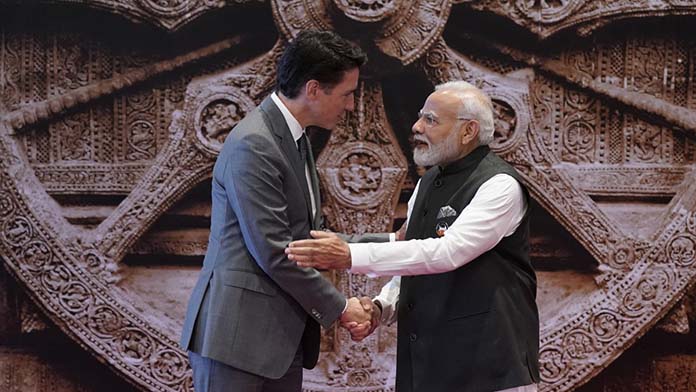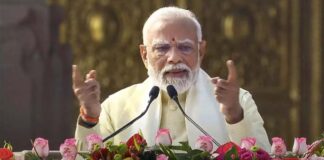The Indian government has been accused of assassinating a Sikh activist in Canada, with Canadian Prime Minister Justin Trudeau declaring there he had “credible reasons” to believe it was responsible.
Canada has shared evidence with the Five Eyes spy network, which also includes Australia, the US, UK, and New Zealand.
This has triggered a diplomatic brawl between Canada and India, and comes at an inconvenient time for both the Australian and US governments, as they seek to court Indian Prime Minister Narendra Modi as an ally against China.
The accusations are all too believable in the light of Modi’s extreme Hindu nationalism and growing authoritarianism.
Modi has been India’s Prime Minister since 2014 and leads the Bharatiya Janata Party (BJP), the Indian People’s Party. It promotes Hindutva, or “Hinduness”, as the only authentic expression of India, and is linked to the fascist paramilitary organisation Rashtriya Swayamsevak Sangh (RSS).
Modi has built his career through encouraging hatred against religious minorities, particularly Muslims. In 2002, while governor of Gujarat state, he allowed horrific anti-Muslim riots that saw over 2000 killed.
Communal violence is now commonplace, encouraged by the BJP and its allies.
In August Hindu extremist mobs attacked and set fire to mosques across Haryana state, with an imam beaten and stabbed to death.
Modi’s party blamed Muslims for sparking the clashes, and responded by bulldozing 300 Muslim homes and businesses.
Alongside this Modi has launched a crackdown on all forms of political opposition. Amnesty International says there is “a continuing pattern of harassment and intimidation” against journalists and activists, including arbitrary arrests and police raids.
Sikhs in India
Hardeep Singh Nijjar, a supporter of a separate Sikh state, was gunned down in June outside a Sikh temple near Vancouver. India had declared Nijjar a terrorist but his family say his activism was entirely non-violent.
There are around 21 million Sikhs in India. They make up around 2 per cent of the population but close to 60 per cent in Punjab state.
Calls for an independent Sikh state date back to Indian independence and the partition of the country in 1947. But Sikhs have historically been privileged compared to the Hindus they work alongside, and Sikh extremist groups have organised communal attacks against Hindus in the past.
In the 1970s and 1980s an armed movement for an independent state, known as Khalistan, emerged that was violently suppressed by the Indian government. Government forces killed thousands of Sikhs and the leadership of the rebellion sought refuge in the Golden Temple complex in Amritsar in 1982.
Indian Prime Minister Indira Gandhi sent in the army to storm the complex, killing hundreds of militants and outraging Sikhs by ransacking one of their holiest sites.
A few months later, Indira Ghandi was shot dead by her own Sikh bodyguards. This set off a series of pogroms and a further wave of state violence against Sikhs.
While the armed insurgency has ended and the movement for Khalistan has declined it retains some support, including within the diaspora in Canada, the US, and Australia.
Sikhs have sometimes been targeted by the Modi government and Hindu nationalists. When massive farmers’ protests began in 2020 against Modi’s neo-liberal reforms, a convoy of over 10,000 farmers and tractors descending on the capital New Delhi. With Sikhs from Punjab heavily involved, authorities blamed the movement on Sikh separatists and claimed they were working for Pakistan.
This was part of an effort to stir up mob violence against Sikhs, with the BJP holding threatening rallies outside Sikh temples and Hindu nationalists talking of the need to “repeat 1984” and the wave of anti-Sikh pogroms.
The Australian government is desperate to draw India into the anti-China alliance alongside the US, with the country’s enormous population set to make it a key strategic player in the region over coming decades. India is part of the Quad alliance aimed at countering China, alongside Australia, the US and Japan.
In May Anthony Albanese lavished praise on Modi during his visit to Australia, declaring him “the boss” in front of an audience of 20,000 people at Sydney’s Olympic Park. Albanese told parliament that ties with India were, “a relationship we need to invest in”.
Hindu nationalism has also surfaced in Australia among an Indian-Australian population that now numbers almost 800,000. Last week a video was circulated on social media of Hindu extremists staging a march through Harris Park in Sydney.
Protests by Sikh Khalistan activists in Australia have also been targeted, including an unofficial referendum on independence in February.
The Australian government is turning a blind eye to Modi’s extreme Hindu nationalism in an effort to boost Western power against China. We need to build solidarity with Indian workers, Muslims and all those targeted by Modi and India’s far right.
By James Supple






